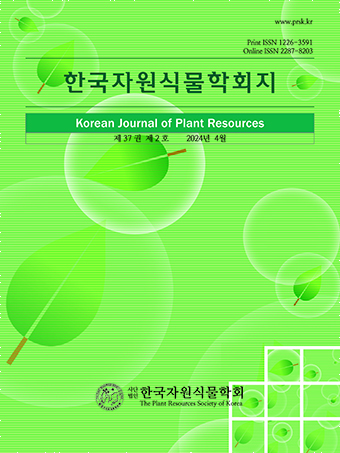Research Article
Abstract
References
Information
Bammou, L., M. Belkhaouda, R. Salghi, O. Benali, A. Zarrouk, H. Zarrok and B. Hammouti. 2014. Corrosion inhibition of steel in sulfuric acidic solution by the Chenopodium Ambrosioides Extracts. Journal of the Association of Arab Universities for Basic and Applied Sciences 16(1):83-90.
10.1016/j.jaubas.2013.11.001Bezerra, J.W.A., A.R. Costa, M.A. de Freitas, F.C. Rodrigues, M.A. de Souza, A.R.P. da Silva, A.T.L. dos Santos, K.V. Linhares, H.D.M. Coutinho and J.R. de Lima Silva. 2019. Chemical composition, antimicrobial, modulator and antioxidant activity of essential oil of Dysphania ambrosioides (L.) Mosyakin & Clemants. Comp. Immunol. Microbiol. Infect. Dis. 65:58-64.
10.1016/j.cimid.2019.04.01031300127Brahim, M.A.S., M. Fadli, L. Hassani, B. Boulay, M. Markouk, K. Bekkouche, A. Abbad, M.A. Ali and M. Larhsini. 2015. Chenopodium ambrosioides var. ambrosioides used in Moroccan traditional medicine can enhance the antimicrobial activity of conventional antibiotics. Ind. Crop. Prod. 71:37-43.
10.1016/j.indcrop.2015.03.067Cheng, J., Z. Zhao, B. Li, C. Qin, Z. Wu, D.L. Trejo-Saavedra, X. Luo, J. Cui, R.F. Rivera-Bustamante and S. Li. 2016. A comprehensive characterization of simple sequence repeats in pepper genomes provides valuable resources for marker development in Capsicum. Sci. Rep. 6:18919.
10.1038/srep1891926739748PMC4703971Chung, H.J., J.D. Jung, H.W. Park, J.H. Kim, H.W. Cha, S.R. Min, W.J. Jeong and J.R. Liu. 2006. The complete chloroplast genome sequences of Solanum tuberosum and comparative analysis with Solanaceae species identified the presence of a 241-bp deletion in cultivated potato chloroplast DNA sequence. Plant Cell Rep. 25(12):1369-1379.
10.1007/s00299-006-0196-416835751Kadereit, G., E.V. Mavrodiev, E.H. Zacharias and A.P. Sukhorukov. 2010. Molecular phylogeny of Atripliceae (Chenopodioideae, Chenopodiaceae): implications for systematics, biogeography, flower and fruit evolution, and the origin of C4 photosynthesis. Am. J. Bot. 97(10):1664-1687.
10.3732/ajb.100016921616801Kim, S.H., J. Yang, J. Park, T. Yamada, M. Maki and S.C. Kim. 2019. Comparison of Whole Plastome Sequences between Thermogenic Skunk Cabbage Symplocarpus renifolius and Nonthermogenic S. nipponicus (Orontioideae; Araceae) in East Asia. Int. J. Mol. Sci. 20(19):4678.
10.3390/ijms2019467831547213PMC6801674Pandey, A.K., U.T. Palni and N. Tripathi. 2014. Repellent activity of some essential oils against two stored product beetles Callosobruchus chinensis L. and C. maculatus F. (Coleoptera: Bruchidae) with reference to Chenopodium ambrosioides L. oil for the safety of pigeon pea seeds. J. Food Sci. Technol. 51(12):4066-4071.
10.1007/s13197-012-0896-425477682PMC4252434Pavela, R., F. Maggi, G. Lupidi, H. Mbuntcha, V. Woguem, H.M. Womeni, L. Barboni, L.A. Tapondjou and G. Benelli. 2018. Clausena anisata and Dysphania ambrosioides essential oils: from ethno-medicine to modern uses as effective insecticides. Environ. Sci. Pollut. R. 25(11): 10493-10503.
10.1007/s11356-017-0267-928965298Stohlgren, T.J., L.L. Loope and L.J. Makarick. 2013. Invasive plants in the United States national parks. In Foxcroft, L.C., P. Pyšek, D.M. Richardson, and P. Genovesi (eds.), Plant Invasions in Protected Areas: Patterns, problems and challenges, Springer, Dordrecht, Netherlands. pp. 267-283.
10.1007/978-94-007-7750-7_13Sukhorukov, A.P., M.V. Nilova, A.A. Krinitsina, M.A. Zaika, A.S. Erst and K.A. Shepherd. 2018. Molecular phylogenetic data and seed coat anatomy resolve the generic position of some critical Chenopodioideae (Chenopodiaceae-Amaranthaceae) with reduced perianth segments. PhytoKeys 109: 103-128.
10.3897/phytokeys.109.2895630386165PMC6209657Würschum, T., S.M. Langer, C.F.H. Longin, V. Korzun, E. Akhunov, E. Ebmeyer, R. Schachschneider, J. Schacht, E. Kazman and J.C. Reif. 2013. Population structure, genetic diversity and linkage disequilibrium in elite winter wheat assessed with SNP and SSR markers. Theor. Appl. Genet. 126(6):1477-1486.
10.1007/s00122-013-2065-123429904Xie, D.F., Y. Yu, Y.Q. Deng, J. Li, H.Y. Liu, S.D. Zhou and X.J. He. 2018. Comparative analysis of the chloroplast genomes of the Chinese endemic genus Urophysa and their contribution to chloroplast phylogeny and adaptive evolution. Int. J. Mol. Sci. 19(7):1847.
10.3390/ijms1907184729932433PMC6073864Pandey, A.K., U.T. Palni and N. Tripathi. 2014. Repellent activity of some essential oils against two stored product beetles Callosobruchus chinensis L. and C. maculatus F. (Coleoptera: Bruchidae) with reference to Chenopodium ambrosioides L. oil for the safety of pigeon pea seeds. J. Food Sci. Technol. 51(12):4066-4071.
10.1007/s13197-012-0896-425477682PMC4252434Pavela, R., F. Maggi, G. Lupidi, H. Mbuntcha, V. Woguem, H.M. Womeni, L. Barboni, L.A. Tapondjou and G. Benelli. 2018. Clausena anisata and Dysphania ambrosioides essential oils: from ethno-medicine to modern uses as effective insecticides. Environ. Sci. Pollut. R. 25(11): 10493-10503.
10.1007/s11356-017-0267-928965298Stohlgren, T.J., L.L. Loope and L.J. Makarick. 2013. Invasive plants in the United States national parks. In Foxcroft, L.C., P. Pyšek, D.M. Richardson, and P. Genovesi (eds.), Plant Invasions in Protected Areas: Patterns, problems and challenges, Springer, Dordrecht, Netherlands. pp. 267-283.
10.1007/978-94-007-7750-7_13Sukhorukov, A.P., M.V. Nilova, A.A. Krinitsina, M.A. Zaika, A.S. Erst and K.A. Shepherd. 2018. Molecular phylogenetic data and seed coat anatomy resolve the generic position of some critical Chenopodioideae (Chenopodiaceae-Amaranthaceae) with reduced perianth segments. PhytoKeys 109: 103-128.
10.3897/phytokeys.109.2895630386165PMC6209657Würschum, T., S.M. Langer, C.F.H. Longin, V. Korzun, E. Akhunov, E. Ebmeyer, R. Schachschneider, J. Schacht, E. Kazman and J.C. Reif. 2013. Population structure, genetic diversity and linkage disequilibrium in elite winter wheat assessed with SNP and SSR markers. Theor. Appl. Genet. 126(6):1477-1486.
10.1007/s00122-013-2065-123429904Xie, D.F., Y. Yu, Y.Q. Deng, J. Li, H.Y. Liu, S.D. Zhou and X.J. He. 2018. Comparative analysis of the chloroplast genomes of the Chinese endemic genus Urophysa and their contribution to chloroplast phylogeny and adaptive evolution. Int. J. Mol. Sci. 19(7):1847.
10.3390/ijms1907184729932433PMC6073864- Publisher :The Plant Resources Society of Korea
- Publisher(Ko) :한국자원식물학회
- Journal Title :Korean Journal of Plant Resources
- Journal Title(Ko) :한국자원식물학회지
- Volume : 32
- No :6
- Pages :644-668
- Received Date : 2019-09-30
- Revised Date : 2019-10-29
- Accepted Date : 2019-11-14
- DOI :https://doi.org/10.7732/kjpr.2019.32.6.644




 Korean Journal of Plant Resources
Korean Journal of Plant Resources







